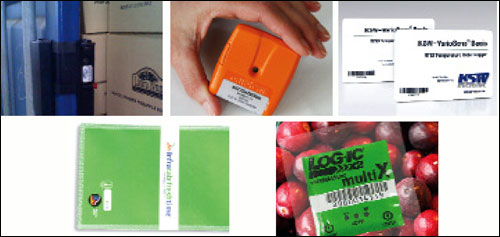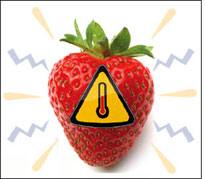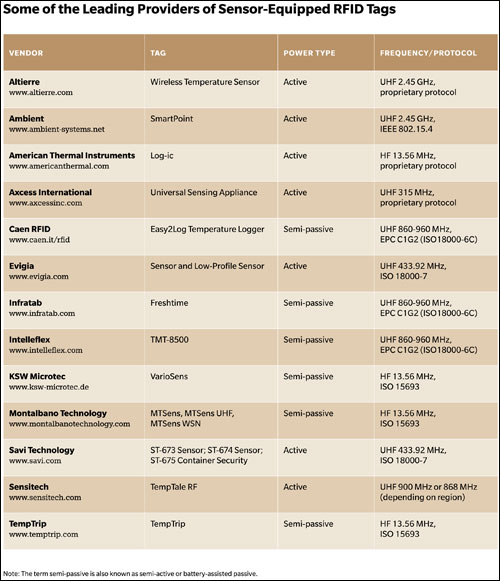Oct 01, 2010Despite the current locavore trend, many of the perishable foods we consume are not produced locally. For freshness and safety, dairy, meat, poultry, seafood, and fruits and vegetables shipped cross-country or overseas must be monitored closely, to ensure they never fall above or below set temperature ranges. Foods stored and shipped at improper temperatures can lead to waste. "If a grocer turns away an entire truckload of strawberries due to spoilage, that's a $40,000 loss," says Michael McCartney, founder and principal at QLM Consulting, an RFID consulting firm that serves the food industry. More alarming is the threat of food-borne illnesses and deaths that can result when bacteria or viruses grow on temperature-sensitive foods.
Many shipping companies use digital data loggers to monitor individual cases, pallets or containers of perishable foods, because the temperatures within a truck can vary, depending on location and loading patterns. Temperatures also fluctuate as the refrigeration system moves through its cooling cycles or when a truck's doors are opened and closed.
But digital data loggers, which take periodic readings of temperature and/or humidity and record the data, have limited functionality. They require a physical connection to retrieve the information, which is a time-consuming process. And by the time you learn that, say, several pallets fell outside their optimal temperature range while in transit, the damage is already done.
That's why early adopters in the food industry are turning to sensor-equipped RFID tags. These tags can automate the collection of data on environmental conditions, making it more cost-effective. Companies can use trucks equipped with a cellular or satellite communication link and GPS receiver to monitor the locations and environmental conditions of food during transit in real or near-real time. The tags, which generally include lights or audio features, can be set to trigger alerts when they sense conditions that can affect the quality of perishables, so steps can be taken to correct the problem, reroute the shipment to a closer location or advise retailers to sell the goods upon arrival—all of which can lead to safer, more attractive foods, reduced waste and longer shelf life.
"The opportunity to track your products at the pallet or box level is very important," says Maurizio Turri, assistant lab manager at the University of Arkansas' RFID Research Center, which works with companies on cold-chain pilots using sensor-equipped RFID tags. (Cold chain refers to any perishable good in transit, whether it needs to be kept at low or high temperatures.) "The temperature around a thermostat is not necessarily what the product is experiencing," he says.
When RFID Journal first wrote about RFID cold-chain monitoring in 2007, tag costs, reliability and interoperability with retail RFID systems were deterrents (see Cold Chain Heats Up RFID Adoption.). When we revisited the topic in 2008, interoperability was still a concern (see Get a Better Sense of Your Product's Condition.). Today, those issues have been addressed, and real-world deployments are documenting the business case. To ensure a successful implementation of the technology, read the information below. Then check the table on the next page for a list of some of the leading vendors that make sensor-equipped RFID tags for your application.
The sensor-equipped RFID tags used to track perishable foods typically monitor temperature; some also track humidity, and some track both conditions. They all have an internal clock that associates a timestamp with each piece of sensory data collected, so users know what time and for how long conditions varied. But the amount of memory is different from one tag to another—some tags have enough memory to store more than 60,000 readings while others store as few as 1,000 readings.
Active and semi-passive systems are not interoperable, so it's best to know the differences upfront. Active tags rely on an onboard battery to power both the sensor(s) embedded in the tag and the data transmission between the tag and reader. Semi-passive (also called semi-active) tags contain a battery used only to operate the sensor(s) and store the data; the tag's data transmission is done passively, using RF energy from the reader.

Semi-passive temperature-tracking tags that operate in the high-frequency (HF) range (13.56 MHz) and comply with the ISO 15693-3 standard have been available for years. The main advantage these tags offer over conventional, static temperature loggers is the ability to collect data automatically—you don't have to remove them from the case or pallet in which they're placed. HF tags have a read range of about 10 inches. With tag costs low—generally less than $10 per tag—end users can realize a speedy return on their investments through reduced waste and longer shelf life, as well as reduced labor costs.
Citrus growers in Mexico use TempTrip's HF temperature-tracking tags to monitor produce being shipped to the United States. The trucks sometimes dwell at border gates—with the truck doors ajar for inspection—so the tags let employees at U.S.-based distribution centers quickly identify which cases have been exposed to dangerously high temperatures. Based on the temperature data logged on each tag, software then estimates the shelf life of each case, so the ripest fruit is sold first, reducing waste and improving sales.
The new semi-passive ultrahigh-frequency (UHF) temperature-tracking tags that are compliant with the EPC Gen 2 standard offer advantages over HF tags—especially for food producers, shippers and retailers that want to track goods in an open supply chain. These tags let cold-chain trading partners leverage existing EPC Gen 2 reader infrastructures to encode data to and collect data from the tags, and to use EPC Information Services (EPCIS) servers to share information. Retailers and logistics companies that already use EPC Gen 2 readers to track dry goods can now track the temperatures and locations of perishable goods the same way they track other items.
The UHF tags also have a longer read range than HF tags—20 feet or more—making it easier to collect data. A recently ratified ISO protocol—180006c class 3—supports a read range of 100 meters. To date, Intelleflex is the only vendor of class 3 readers and tags, which also comply with the EPC Gen 2 protocol. The newly available or soon-to-be-released UHF EPC Gen 2 semi-passive tags cost as little as $10 to $15 per tag when purchased in volume.
Several major food producers and retailers are conducting cold-chain pilot projects with semi-passive UHF tags, QLM'S McCartney says, though he declines to identify the companies. One such pilot involves temperature-sensing tags embedded in reusable plastic containers used to transport perishables.
Active tags might be the best solution if the business case requires a very long read range and high data storage, and if you want to determine the location of the products as well as their condition in real or near-real time. (You can determine the last-known location of a semi-passive tag by noting the last place and time it was read by a handheld or fixed-position RFID reader. But real-time tracking with semi-passive tags is cost-prohibitive for most end users, because a high number of readers would need to be placed inside trucks or cargo containers.)
To view a larger version of the above chart, click here.
Active tags are more powerful than most semi-passive tags, in terms of the distance from which they can be read—hundreds of feet, vs. tens of feet with semi-passive UHF tags and roughly 10 inches with semi-passive HF tags. Active tags also tend to sport more power in terms of memory, which allows for a greater number of data points collected than from semi-passive tags. But their added features and capabilities come at a price—up to $100 for a single tag.
Spanish strawberry grower Bionest is using active RFID tags with built-in sensors to monitor the temperature of strawberries packed at its processing facility, as well as record temperature fluctuations in a truck while the berries are transported, and once the goods are stored at retailer distribution centers. The tags, from Dutch RFID firm Ambient Systems, operate at 2.4 GHz, using an air-interface protocol based on the IEEE 802.15.4 standard, which allows tags to communicate with each other and pass data along to a reader network in Bionest's facilities.
Savi Networks makes an RFID sensor tag designed to double as a security system. The tag's sensors, which monitor temperature, humidity and shock, are positioned inside a locking cargo container. The outer part of the tag, which secures it onto the container, houses a GPS receiver. Using a cellular network, the tag broadcasts its location and the environmental conditions inside the container to Savi's network. If the seal is tampered with, the tag sends an alert over the same network.
New technology might soon bridge the gap between capabilities of semi-passive and active sensor tags. The Dash7 Alliance, a consortium formed to advance the use of RFID technology compliant with the ISO 18000-7 standard, which is based on 433-MHz tags made by Savi Networks, has introduced a new specification, known as Mode 2, for ISO approval. This specification for active 433-MHz RFID tags and readers would allow the integration of 433-MHz active and 13.56-MHz passive RFID on a single tag.
Several recent advancements are making sensor-equipped RFID tags more reliable and economical. Better batteries and integrated circuit designs allow tag-makers to manufacture their products more quickly and inexpensively. The availability of integrated circuits that support multiple sensors is another important advancement in tag design, QLM's McCartney says, because they simplify tag design.
Some semi-passive tags with low memory are designed for one-time use, but most sensor-equipped RFID tags are designed for repeated use, which extends their value and allows the user to recoup their costs over time. You also need to factor in the costs for a reader infrastructure, software and a system to present the tag data through graphs or other digestible formats to supply-chain partners. In recent years, the costs of these elements have fallen steadily. Cloud computing platforms are lowering software costs and allow companies to test the technology with minimal investments. And the growth of onboard cellular and satellite technology in long-haul trucks makes real-time tracking less expensive.
The cost of monitoring the condition of perishable foods with RFID must be balanced with the potential return on investment. "Shelf life is where the ROI is," McCartney says. The math here is simple, he explains. The more triggers that producers and logistics companies can use to ensure optimal conditions during food's transport, the fresher the foods will be when they land on store shelves. And the more grocers know about each tomato or chicken fillet they sell, the better they'll be able to manage inventory, through sales or promotions, for example, to boost sales and reduce waste.
Waste reduction is motivating many sensor tag tests and deployments in countries where food waste is a major problem, McCartney says. In South Korea, for example, which relies heavily on imported fresh foods, up to 25 percent of all perishables are tossed each year, compared with 10 percent in the United States, he says. For this reason, the South Korean government is sponsoring a number of end-to-end pilots in which temperature-tracking tags are placed in cases of fresh foods in their country of origin. The tags collect data throughout the goods' transport, and retailers can then provide freshness data and more accurately estimate a "use before" date for consumers.
There are also potential labor savings to be factored in. Researchers at the University of Florida's department of agricultural and biological engineering have determined that using RFID tags at the case and pallet level to monitor the temperature of produce in transit could lead to a 20 percent reduction in labor costs. That's because retailers could rely on the temperature data collected from the individual tags when they receive shipments, and inspect only cases or pallets that have been exposed to unsafe temperatures, rather than inspecting the complete shipment.
"Our clients are now talking in terms of equivalent revenue, [which] tends to get management's attention very quickly," McCartney says. "A product loss of $100,000 at 4 percent profit margin is equivalent to $2.5 million in revenue, for example." In other words, the producer would need to sell another $2.5 million worth of produce to recoup that $100,000 loss.
CAPS:


